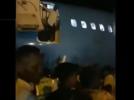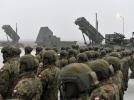Sichuan A319 at Wuxi on Sep 14th 2010, full stall condition on approach in microburst
A Sichuan Airlines Airbus A319-100, registration B-6054 performing flight 3U-8949 from Chongqing to Wuxi (China), was following the Lushui01 standard arrival procedure in order to perform an ILS approach to Wuxi's runway 03 in adverse weather conditions, ATIS reported light thunderstorm over the aerodrome, light fog, visibility of 2400 meters, surface winds at 6 knots from 040 degrees, when upon first contacting tower about 33 minutes prior to estimated arrival the crew was told the terminal area was covered by a thunderstorm, the situation was forecast to improve in about 60 minutes, a number of aircraft preceding flight 3U-8949 had diverted to Nanjing (China) due to weather. There was strong lightning to the west of the terminal area. The aircraft continued the approach and about 28 minutes later, 5 minutes prior to estimated arrival, was cleared to join the downwind leg to join the localizer for runway 03. One minute later gusts with winds up to 14 knots from 340 degrees were recorded at the aerodrome, at about the same time the aircraft just intercepted the localizer runway 03 at 2140 feet MSL with automation, autopilot and autothrust, engaged, however, the indicated airspeed began to decay and the attitude began to gradually increase. When the indicated airspeed decreased through 114 knots (Vapp 126 knots) an automated "SPEED" warning was triggered. A target speed of 131 KIAS was selected into the speed window of the flight control unit. Autothrust began to accelerate the engines slowly, however, speed was already decreasing at 7 knots per second, the autopilot automatically disconnected, the Alpha Protection function activated. Alpha Floor activated when the speed reached 83 KIAS, the aircraft reached a minimum speed of 74 KIAS before the aircraft began to accelerate again, the maximum angle of attack was 33.4 degrees together with right roll and loss of altitude. The aircraft reached 43.6 degrees right roll, 3924 feet rate of descent, the EGPWS sounded "Glideslope", "PULL UP" and "SINKRATE" in sequence. As the aircraft lost altitude and gradually increased speed, the crew, now manually controlling the aircraft now with flight augmentation computers 1 and 2 inoperative, gradually regained control of the aircraft, arrested the descent at 884 feet MSL and began to climb the aircraft again. During the climb to 2924 feet MSL the crew stabilized the aircraft, subsequently reset both flight augmentation computers following the ECAM procedures, and subsequently diverted to Ningbo (China) for a safe landing about 40 minutes after the loss of control and fully developed stall. The crew informed dispatch and flight operations, maintenance checked the aircraft and released the aircraft to flight, flight operations decided to have crew and aircraft continue the schedule.
China's Civil Aviation Authority (CAAC) released their final report via the French BEA (the report does not appear, not even in Chinese, on usual CAAC websites, that used to report aviation safety occurrences until July 2010, at which point all aviation safety reporting on CAAC websites stopped with the only exception of the final report into the crash of Henan Airlines in Yichun) concluding the probable causes of the serious incident (major aviation transport incident) were:
Findings
- The crew did not pay enough attention to the complex weather condition, and their decision-making ability was weak. The crew had made wrong decisions in the severe weather condition. Although ATC informed the pilots of the weather conditions and other planes’ diversion, the flight crew continued to launch the approach.
- The alternative plan prepared for complex weather condition was insufficient. When wind shear became obvious, pilots took no resolute action to stop the approach.
- The crew failed to respond as per manual. When the aircraft attitude was gradually deviating from norm, air speed decreased and low energy warning appeared, the pilots intervened in the AP control by choosing the speed manually instead of pushing the throttle forward as QRH2.03, leading to complex situation, including increasing attitude, low airspeed, Alpha Protection triggered and stall.
- The Crew Resource Management was a chaos. When aircraft was in complex conditions, pilots reacted out of their instinct, leading to dual side stick inputs for as long as 12s.
Cause
In accordance with article 3.13 of Civil Aircraft Incident, this is a serious air transport incident, caused by flight crews’ inappropriate decisions and handling under adverse weather conditions.
The CAAC analysed based on QAR data analysis, that the aircraft encountered straight cross winds of between 25 and 50 knots while turning final and intercepting the localizer, that within 5 seconds changed to a tail wind of about 30 knots and a vertical downdraft of 30 knots. During the encounter the angle of attack reached a maximum of 33.4 degrees nose up and 5.98 degrees nose down, the bank angle varied between 43.54 degrees right and 7.03 degrees left, the maximum rate of descent was 3924 feet per minute and the lowest indicated airspeed was 74 knots (stall speed at 99 KIAS) reaching that low within 18 seconds from 127 KIAS, the angle of attack rose from 10.2 degrees nose up to 33.4 degrees nose up in the same time. The CAAC annotated that the angle of attack prrior to the stall event had already been unusually high at 10.2 degrees probably due to the vertical downdraft already present, usual angle of attack is around 4 degrees nose up.
According to the QAR the alpha protection activated at 93 KIAS and controlled the elevators fully down for a period of 7 seconds, causing both flight augmentation computers to drop offline and causing the pitch angle to reduce from 34 to 4 degrees nose up, the angle of attack however continued to increase until reaching 32.4 degrees until finally gradually reducing and decreasing below the alpha protection limit.
The CAAC stated: "Meanwhile, Alpha Protection function was activated to make the aircraft nose down, and gradually recovered the aircraft, which demonstrated the effective protection."
At that time Alpha Floor activated accelerating the engines from 1.27 EPR at that time to TOGA within 2 seconds causing the aircraft to pitch up again and again exceeding the Alpha Protection Limit (AoA at or above 13 degrees nose up). The autopilot was automatically disconnected at that point, the stall warning activated for 6 seconds. The CAAC analysed, that the vertical acceleration (wing load) at that time was 0.8, not 1.0G, thus reducing the actual stall speeds. According to QAR the angle of attack again exceeded 23 degrees (activation of stall warning) at a speed between 93 and 81 KIAS (no further accuracy possible due to QAR sampling intervals of 1 second) leading to the conclusion that in the attitude and wing load situation of the aircraft the actual stall speed was 79 knots.
The CAAC stated: "The triggered stall warning as shown by the decoded data was between 93kt and 81kt (CAS), higher than 79kt, demonstrating that the stall warning was triggered before the aircraft stalled."
The CAAC summarized the analysis: "Under the Influence of microburst and the following windshear, the aircraft attitude changed significantly. Although the Alpha Protection function was activated before stall, it was still quite hard to effectively stop the aircraft from stalling, because the energy produced by the weather at that time had exceeded that of auto protection system."
The wind graphs (Graphics: CAAC):
http://avherald.com/h?article=46c38481














Komentarze